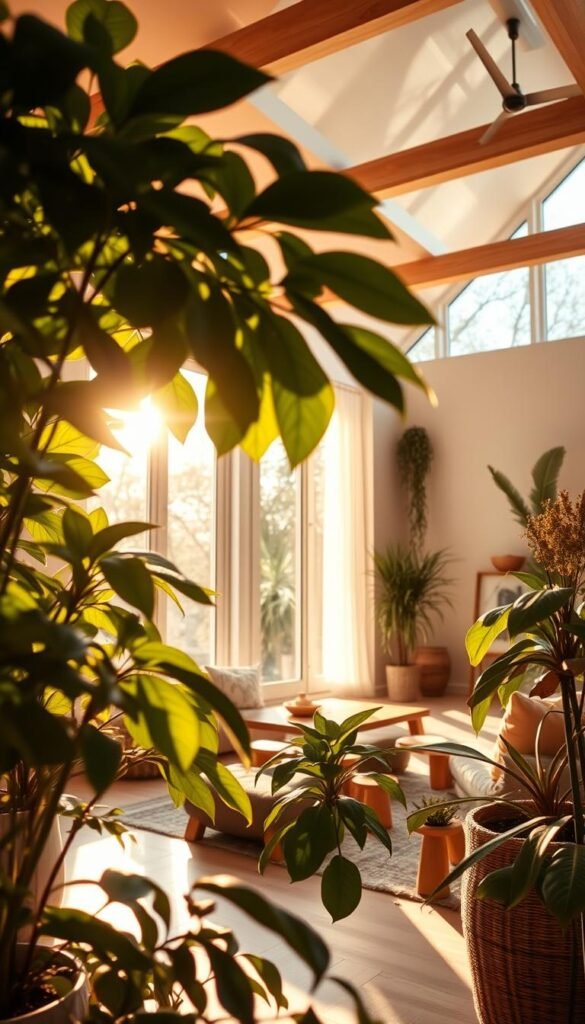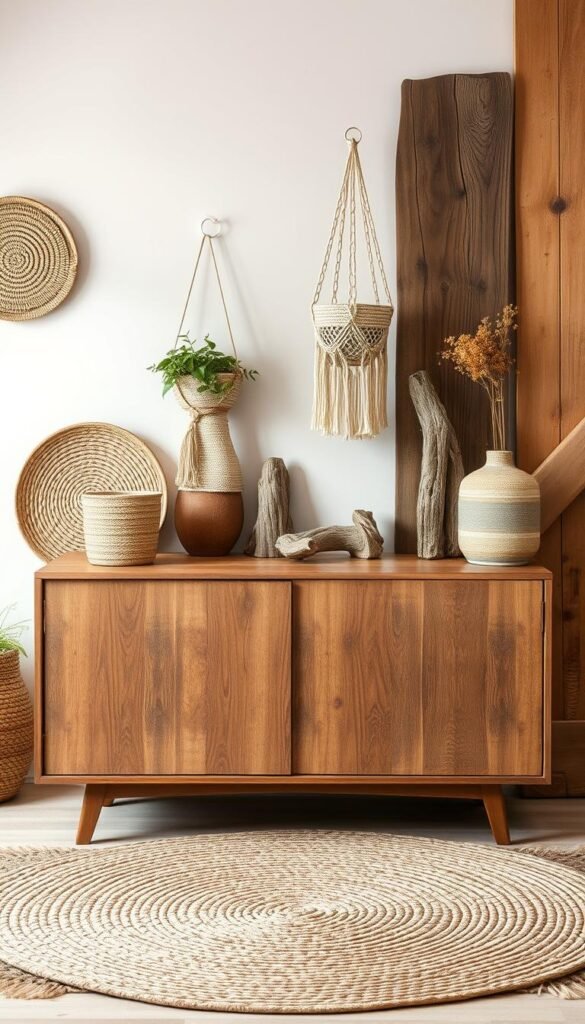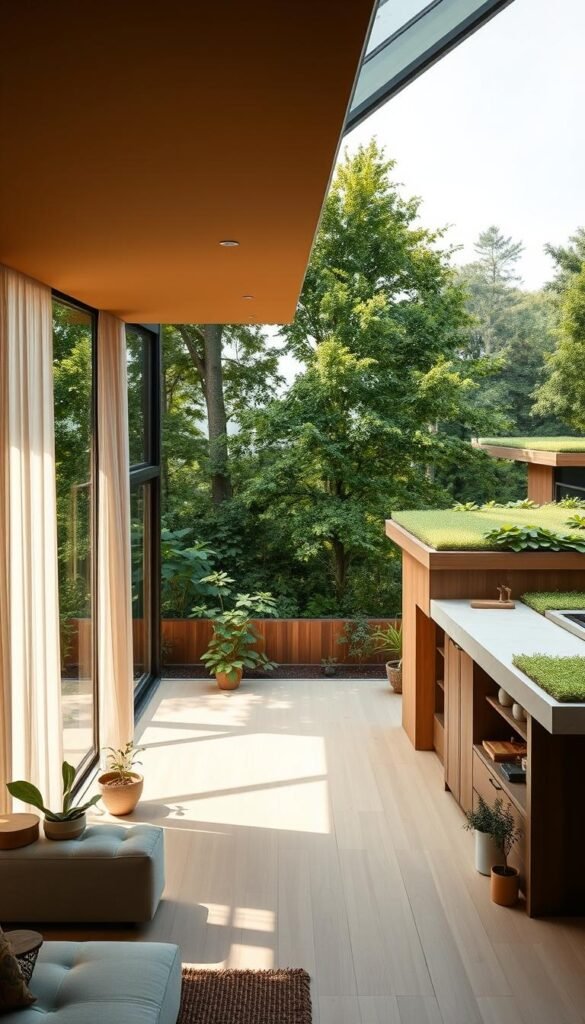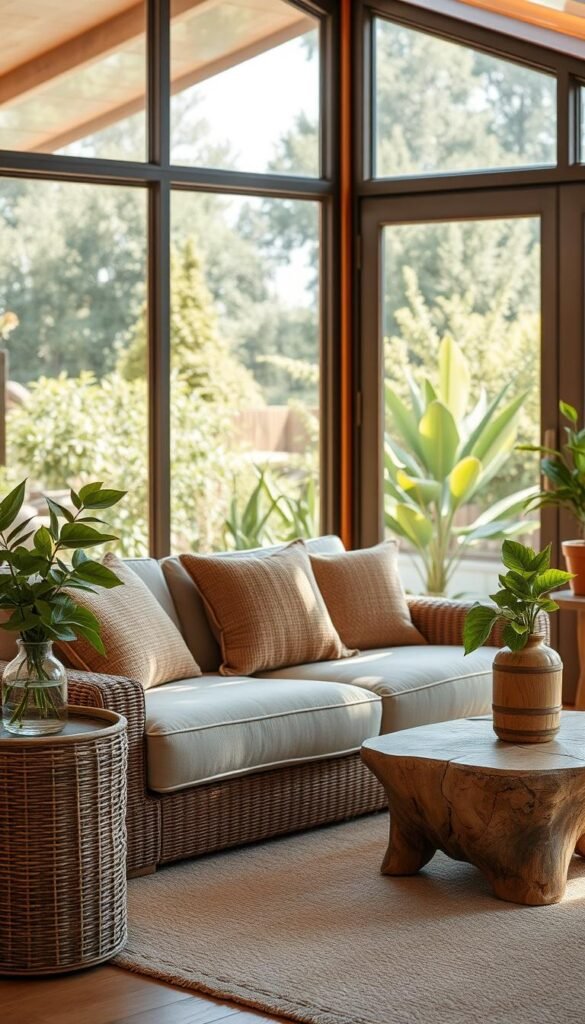Your home is more than just a place to live—it’s a reflection of your values. Transforming your space with eco-conscious choices doesn’t mean sacrificing style. By blending timeless design with materials like reclaimed wood, organic fibers, and toxin-free finishes, you create a healthier environment while reducing your footprint.
This guide helps you select pieces that balance beauty and purpose. Look for certifications like SFC or GOTS when choosing furniture or textiles—these ensure low environmental impact and safer manufacturing. Brands like Healthier Homes prioritize non-toxic essentials, proving sustainability and sophistication go hand in hand.
Every choice matters. Opting for items free from harmful chemicals improves indoor air quality. Reimagined materials, such as upcycled metals or bamboo, add character without waste. Even small changes—like energy-efficient lighting—elevate your space while protecting the planet.
Your design journey starts here. Let’s build a home that feels good, looks stunning, and respects the Earth—one thoughtful piece at a time.
Understanding Sustainable Decor in a Healthier Home

Creating a home that supports your well-being starts with the elements you bring into it. Thoughtful design focuses on materials and practices that protect both your health and the planet. Let’s explore how simple swaps can transform your space into a sanctuary.
Exploring the Environmental and Health Benefits
Choosing non-toxic products reduces exposure to harmful substances like formaldehyde or VOCs. For example, low-VOC paints minimize fumes, while solid wood furniture avoids the glues found in MDF. These choices lower your environmental impact and create cleaner air.
Natural fibers like organic cotton or jute resist mold and dust mites. They’re gentler on sensitive skin and decompose safely. Pairing these with energy-efficient lighting solutions extends eco-friendly habits beyond indoor spaces.
How Your Decor Choices Impact Indoor Air Quality
Many conventional items release chemicals that linger in your home’s atmosphere. Switching to plant-based cleaners and untreated fabrics cuts these risks. Even adding air-purifying plants like snake plants or peace lilies boosts freshness naturally.
Prioritize certifications like Greenguard or Cradle to Cradle when selecting rugs or wall finishes. These labels ensure products meet strict emissions standards. Over time, these steps reduce headaches, allergies, and long-term health concerns—proving that beauty and wellness truly coexist.
Selecting Natural Materials for an Eco-Aesthetic

The foundation of a mindful home lies in the materials you choose. Every piece tells a story—whether it’s a table crafted from salvaged timber or curtains woven from organic linen. Let’s explore how to curate a space that feels intentional and honors the planet.
Finding Safe, Earth-Friendly Options
Start by prioritizing non-toxic products with certifications like GOTS (textiles) or CertiPUR (foams). These labels guarantee low chemical emissions and ethical production. For example, bamboo flooring resists moisture naturally, while hemp rugs improve air quality by trapping dust.
Look for these seals when shopping:
| Certification | Focus Area | Common Uses |
|---|---|---|
| GOTS | Organic textiles | Bedding, curtains |
| FSC | Responsible forestry | Wood furniture |
| Greenguard | Low emissions | Paints, adhesives |
The Charm of Reclaimed Wood and Fibers
Salvaged wood adds warmth and history to modern design. A barn-door table or vintage shelving unit reduces waste while creating visual interest. Pair these with jute baskets or linen throw pillows for texture.
Natural fibers like wool and cork regulate humidity, making them ideal for walls or flooring. They’re also biodegradable—unlike synthetic alternatives. For inspiration on how these materials influence your design, explore blending eras and textures.
Quick tip: Visit local salvage yards or online marketplaces specializing in upcycled furniture. You’ll often find unique pieces that support circular economies.
Sustainable Decor: Using Natural Materials for an Eco-Aesthetic

Building a thoughtful space starts with knowing where your materials come from. Let’s simplify the process of selecting items that align with your values—without compromising on style or durability.
Step-by-Step Tips for Sourcing Quality Materials
1. Start with certifications: Look for labels like GOTS (textiles) or FSC (wood) to verify ethical production. These ensure low chemical use and responsible sourcing.
2. Test durability first: Compare reclaimed wood and organic fibers by checking grain patterns or weave tightness. Denser materials often last longer.
3. Ask about finishes: Avoid products with synthetic sealants. Instead, choose water-based stains or plant-oil treatments for safer indoor air.
Local artisans often prioritize craftsmanship over mass production. Visit makers’ markets or online platforms emphasizing handcrafted furniture. For smaller spaces, consider vertical gardening solutions that blend functionality with earthy textures.
4. Prioritize transparency: Brands sharing detailed sourcing practices—like reclaimed timber origins or dye processes—build trust. If details are vague, keep searching.
5. Calculate long-term impact: A slightly pricier, durable item creates less waste than replacing cheap alternatives yearly. This mindset shift supports circular economies.
Every informed choice reduces your home’s environmental footprint. Pair these steps with energy-efficient lighting to amplify your efforts. Soon, you’ll craft a space that feels intentional and honors the planet.
Designing Your Space with Eco-Friendly and Modern Aesthetics

Blending nature with modern design creates a home that’s both stylish and kind to the planet. Start by layering earthy textures with sleek lines—think linen couches paired with geometric shelving or a live-edge coffee table beside metallic accents. This balance lets your space feel fresh yet grounded.
Incorporating Indoor Plants and Biophilic Elements
Plants are more than decor—they purify air and boost mood. Try clustering snake plants near windows or hanging pothos in macramé holders. For smaller spaces, mount air plants on driftwood frames or add a tabletop succulent garden.
Biophilic elements extend beyond greenery. Use stone coasters, woven rattan lampshades, or nature-inspired art. These touches connect your home to the outdoors without sacrificing modern flair.
Mixing Natural Textures with Contemporary Styles
Pair reclaimed wood shelves with glossy white walls for contrast. Layer jute rugs under minimalist sofas, or drape organic cotton throws over mid-century chairs. The key is to let raw textures shine against clean backdrops.
- Combine bamboo blinds with metallic light fixtures
- Use cork wall panels as accent pieces
- Style ceramic vases with dried branches
Choose lighting that merges form and function—solar-powered pendant lights or LED sconces with rattan shades. These choices reduce energy use while elevating your room’s aesthetics.
Your home becomes a canvas where eco-conscious design meets personal expression. Experiment freely—every thoughtful detail tells a story.
Enhancing Indoor Air Quality and Overall Home Health

Did you know indoor air can be 2-5 times more polluted than outdoor air? The finishes and paints you choose play a huge role. Harmful chemicals like VOCs (volatile organic compounds) linger in your home, affecting both health and comfort. Making smarter choices here creates a safer environment for your family.
How to Pick Safer Paints and Finishes
Low-VOC or zero-VOC paints reduce airborne toxins by up to 90% compared to conventional options. Look for certifications like GreenGuard Gold or EC1, which test for chemical emissions. Water-based finishes are gentler than oil-based ones—ideal for walls or furniture.
Avoid products with formaldehyde or ammonia. These chemicals can trigger allergies and respiratory issues. Instead, opt for plant-derived sealants or milk paint. Brands like BioShield and ECOS Paints offer vibrant colors without compromising air quality.
Here’s a quick checklist for your next project:
- Check labels for VOC content (aim for
- Prioritize water-based formulas
- Verify third-party certifications
Small swaps, like choosing clay plaster over vinyl wallpaper, make a big difference. Your space becomes a haven—cleaner air, fewer headaches, and lasting peace of mind.
Embracing Energy Efficiency and Sustainable Lighting Solutions

Lighting shapes your home’s mood and footprint. Simple swaps can cut energy bills by up to 75% while elevating your design. Start by replacing outdated bulbs with LED alternatives—they last 25 times longer and use 90% less power.
Smart Choices for Brighter Spaces
LEDs come in warm, cool, or daylight tones to match any space. Pair them with dimmers or motion sensors to reduce unnecessary consumption. For statement pieces, try pendant lights made from recycled glass or bamboo—these merge style with responsibility.
Timers automate your lighting schedule, saving energy when rooms are unused. Solar-powered outdoor fixtures harness daylight, cutting reliance on grids. Brands like Philips Hue offer app-controlled options, letting you adjust brightness from your phone.
Prioritize fixtures with Energy Star certification. These meet strict efficiency standards and often qualify for rebates. A well-lit home isn’t just about watts—it’s about creating warmth that respects the planet.
Bringing It All Together in Your Sustainable Sanctuary
Crafting a home that aligns with your values doesn’t require compromise—it thrives on intention. By blending natural materials like reclaimed wood with non-toxic finishes, you create a space that’s both inviting and responsible. Energy-efficient lighting adds warmth while shrinking your carbon footprint, proving every detail matters.
Your design choices ripple outward. Opting for organic textiles or salvaged furniture reduces waste and supports cleaner air. Even small shifts, like choosing low-VOC paints or LED bulbs, protect your household’s health and the planet.
Keep evolving your approach. Revisit local artisans for unique pieces, or refresh rooms with drought-resistant plants grown through DIY hydroponics. Share your journey—inspire others to see eco-conscious living as stylish, achievable, and rewarding.
Your sanctuary starts now—one mindful choice at a time.






